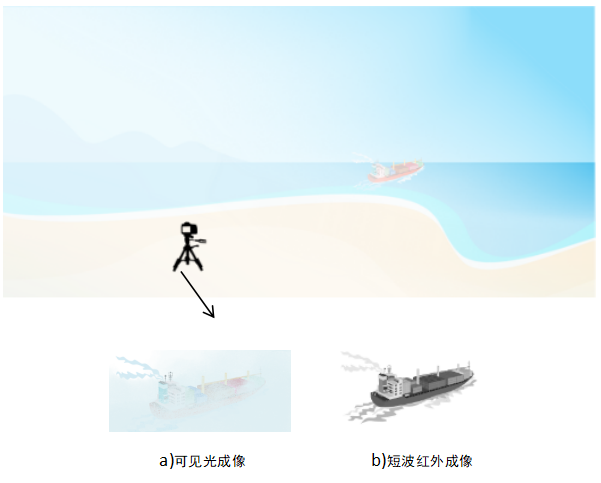 tel
tel
tel
tel
 tel
tel
tel
tel

2024-07-25 15:05:50
Ocean has high humidity and a large temperature difference between day and night, which easily forms fog, haze, and water vapor and the like. Visible light camera can take a good picture under normal conditions, but if there is fog, haze and water vapor, the image would not be as promising. Bad weather would cause low contrast, blurred outlines, and loss of details, making it impossible to clearly identify the target. Thermal imaging has good fog penetration ability, but when the target and background temperatures are close, thermal imaging details would lost, which is not conducive to target detection in ocean areas.

SWIR can also realize long-distance monitoring in bad weather on the sea. Due to its good permeability to fog, the observation of target is rarely affected by rain and fog and has relatively obvious contour and texture characteristics.
SWIR imaging is similar to visible light imaging, and mainly relies on the light signal reflected by the target. Its wavelength range is approximately between 900nm and 2300nm. Because light will be scattered when it encounters molecules, particles, aerosols and a large number of suspended water droplets in the atmosphere, when the scattering particles in the atmosphere are smaller than the wavelength of light, it can be processed according toRayleigh scattering, and the scattering coefficient is

S is the cross-sectional area of the scattering particles, N is the number of particles per unit volume, and λ is the wavelength of the light wave. From the formula, we can see that the longer the wavelength, the weaker the scattering and the stronger the fog-penetrating ability, so SWIR has a stronger ability to penetrate haze than visible light.
As shown in Figure, these are the imaging effect of visible light and SWIR respectively. The details of the ship are more clear in the SWIR image.

Not only that, SWIR also has great advantages in identifying tiny targets on the sea surface. Due to the long shooting distance, the pixels occupied by tiny targets on the detector are small, and the conditions on the sea surface is constantly changing. When the sea clutter interference is too large, the signal of the weak target will be submerged, making it difficult to detect with visible light. However, SWIR is different. By taking advantage of the strong absorption of SWIR by seawater, the recognition ability of weak targets can be greatly improved. Seawater hardly reflects SWIR light, while weak targets reflect SWIR light, which increases the contrast between the background and the target, making it easier to observe weak targets. Therefore, when detecting targets with unclear acoustic, optical and electrical characteristics such as floating ice, small boats, frogmen, buoys, aircraft wreckage, and floating objects on the sea surface, SWIR is more suitable for observation than visible light.
In addition, SWIR technology can also provide high-quality surveillance images at night and in low-light conditions. In coastal ports, night navigation may be risky, and the SWIR monitoring system can ensure that port and ship activities can be monitored in a timely manner even in the dark, thereby improving port safety.
Sales Manager: Lily Liu
Mobile: 086-13359283296
Email: info@gatherstarhk.com
